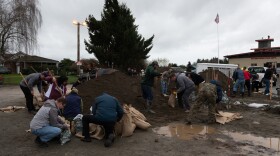Washington Commissioner of Public Lands Dave Upthegrove fulfilled a campaign promise late last month when he announced that 77, 000 acres of structurally complex, mature state forests would be spared from harvest.
The ambitious conservation plan followed an 8-month moratorium on sales and logging of these older trees, issued on his first day in office.
Upthegrove said these forests are more valuable as tools in the fight against climate change.
Critics of the plan dominated public comments at the most recent meeting of the state Board of Natural Resources. Small mills and loggers, county beneficiaries and even some environmental activists opposed to the plan spoke out. Some said it doesn’t do enough to protect the next generation of old growth forests. Most said it goes too far, too fast.
Jake Hambidge is the log buyer with Canyon Lumber in Everett, a family-owned hundred-year-old mill specializing in mass timber that’s made from older trees.
“Roughly 80% of our timber supply comes from DNR lands,” Hambidge said. “Similar to others, over the past eight months, we have faced serious challenges and uncertainties about our future timber supply, due to the pause on mature timber sales.”
Others voiced concerns about the revenue from timber sales that rural counties depend on for schools and other facilities.

Heath Heikkela, representing the American Forest Resource Council, said Upthegrove’s moratorium had already set the state’s logging industry back.
“We fell...nearly 200 million board feet short of last year's timber program, that is a very drastic impact,” Heikkela said.
He called on the board to apply its standards for sustainable harvest levels to Upthegrove’s goals.
“And if anything we could agree on here, in the state of Washington, is that we practice sustainable forestry.”
The agency said its next step is to get the authority from the Washington State Legislature to enter into carbon markets and find other ways to make money from conservation.
Along with the 77,000 acres conserved, it also plans to release 29,000 acres of older forests, for logging – and that those will be enough for it to meet its obligations over the next decade.







